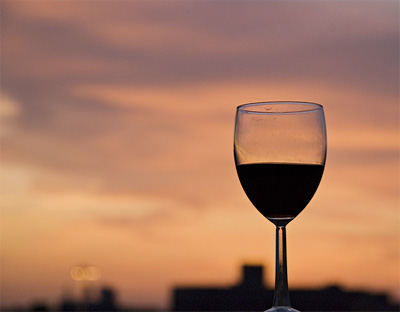You won't find the word "biodynamic" on many wine labels, but if you drink wine, you've probably had several biodynamic bottles. Thirty percent of all wines from Mendocino, for instance, are made from grapes grown according to biodynamic principles.
Following the biodynamic grape growing process, you need to bury a dung-filled cow horn during the autumn equinox, consult the stars, and stir tea for the compost pile in just the right direction. Sounds like a sorcerer's spell, but these techniques are fundamental to the proper practice of biodynamic agriculture. In the late 1920s, these esoteric farming tips came in a vision to Rudolf Steiner, whose educational philosophies still guide Chicago's Waldorf School.
Jens Schmidt, of Montecastelli Selections, is a biodynamic farmer and a distributor of biodynamic wines, and explains, "Conventional agriculture relies on mineral fertilizers that are added to the soil in order to achieve maximum production. It's based on the farmer just depleting the land, taking out energy with the biggest crops he can. Biodynamic farming thinks about the farm as a self-contained entity, as an ecosystem that is basically only temporarily occupied by the farmer himself."
As owner and wine director at Bin 36 and Wine Bin Café, Brian Duncan also produces wine. Having worked side-by-side with biodynamic grape growers, Duncan believes biodynamic wines are the result of "a practice that includes in the philosophy a connection between the land, the air, the environment, the sun, the plant life, the animal life, the microbial life all work together in the health of the vineyard and the end product: the biodynamic wine."
"In a lot of places, especially in South America, they actually bring in animals to close off the system," says Dave Thomas, co-owner of H2Vino and a distributor of biodynamic wines. "That's because some of those animals are not indigenous to the area, and it's so important to have a life-force associated with the vineyards outside of just the human interaction."

photo by Seth Anderson.
Jan Henrichsen, a wine buyer for the Pastoral cheese shops in Chicago, contends that biodynamics transcend the merely organic. "The big thing about biodynamic wine is that most people assume that it's some kind of souped-up organic system, but really it's a little more mystical than that. One of the wackier ideas is the biodynamic calendar. It's based on the position of the stars and the phases of the moon; things are broken up into different sections, so one day will be a fruit day, and so on that fruit day you focus on all plants that are giving fruit. One day is a leaf day, so you focus on all aspects of leaf-giving plants."
There are also very specific directions for how one prepares what goes into the ground, including tea used for composting. As Henrichsen explains, "You actually have to prepare these sorts of teas using valerian flowers and spring water on a wood-burning stove while you stir in a certain direction, and then you have to reverse the direction like every two minutes."
Thomas brings it back to reality. "When you're talking about terroir with wines and with vineyards, you're talking about the grapes and the wines taking on the characteristics of that area. In biodynamic fashion, since the land is so important, as well as the closed system, you'll find that it is far more representative of that terroir than traditional wine."
The non-mystical reason for the expressive quality of biodynamic wine, according to Henrichsen, may be simply that the grape grower focuses so intently upon the process of perfecting of a single piece of land. "You're really thinking about every single action rather than just sort of going out and throwing some more ... Weed-Be-Gone between the rows of grapes and being done with it. So the whole idea is to make you think about everything you're doing in the land. Is it the cow horn, or is it the fact that someone is thinking about the cow horn, and being concerned about the cow horn ... and building a closed system."
There's only one way to evaluate the true value of biodynamic wine, and that's to drink some. Bin 36's Duncan, who sips thousands of wines every year, told me about the biodynamic wines he likes to serve and drink. "I don't say that every biodynamic wine is great, because some winemakers are better than others, but the winemakers I'm choosing. I didn't buy because they were biodynamic. I bought them because the wines themselves were sound and I later found out they were biodynamic, — and that was a plus because I knew they were going to have a little better shelf-life for me, they were going to be wines of great balance, great character."
For Thanksgiving, Duncan suggests a few grape varieties that lend themselves to biodynamic viticulture: "I like to start with a high-acid white wine like a Sauvignon Blanc, those are wines that really get the tastebuds going, gets the palette whetted for the meal to come; it's great for your appetizers and canapés and cheeses... very versatile. Later with the meal, the accompaniments really dictate more extreme flavors, the sweet and sour — so you need a fruitier high acid wine like Riesling or Gewürztraminer, Pinot Gris. These wines really navigate the table beautifully."
Wine buyer Henrichsen is also partial to biodynamic whites at the holiday table, especially a Pinot Gris from Italy. "Baggill Pinot Gris is fantastic; it's got this amazing purity, it tastes like the essence of apricots, and there's great floral notes, beautiful acidity. Because it's so pure and so rich, it's a great counterpoint to cranberries and that slightly sweet thing you have going on in the sweet potatoes."
Here's wishing you a pleasing bellyful of Thanksgiving food and wine, whether biodynamic or more conventionally grown.





